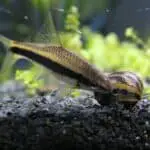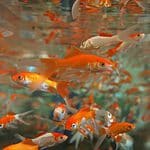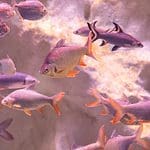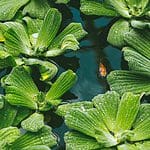KH, or carbonate hardness, is a parameter that still confuses many aquarists. Many do not understand the role of this alkaline reserve in the aquarium and are even more confused when it comes to adjusting it. By adjusting KH wrongly, you can cause a lot of problems for your tank.
Raising the KH is very easy; you will need to supplement the water with a specific product or even use some type of carbonate or bicarbonate. It will not significantly alter the pH and correct the KH effectively when done correctly.
In this guide, we explore the functionality of this parameter and teach you how to raise KH in aquariums.
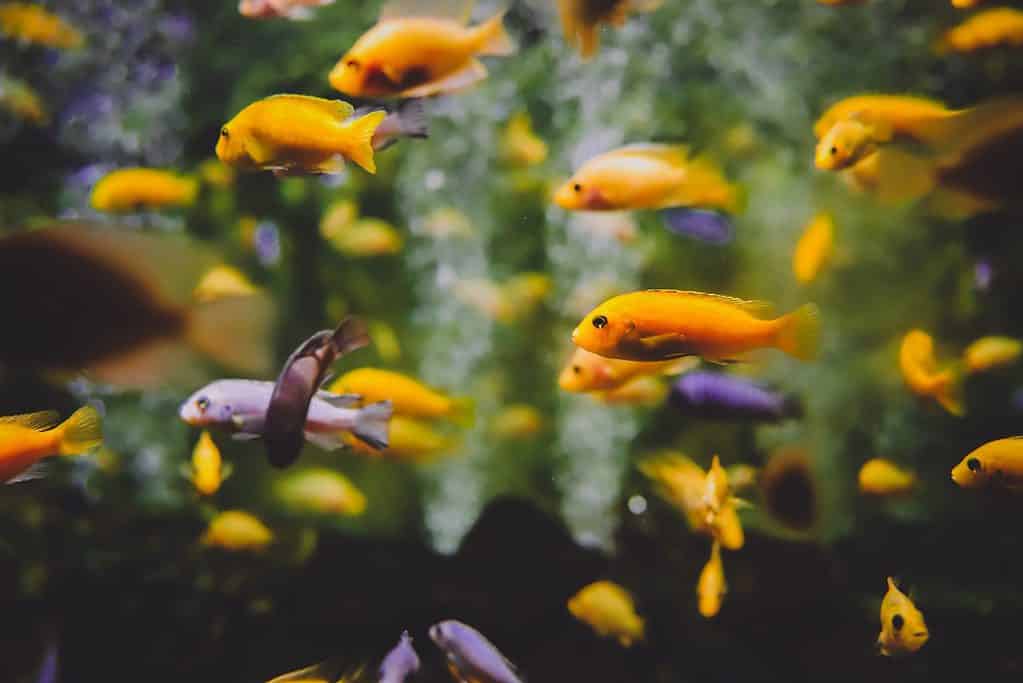
What Is Aquarium KH?
Carbonate hardness is known as alkalinity/KH, alkali potential, buffering capacity, temporary hardness, or unstable fraction of total hardness.
The carbonate hardness is a quantity that refers directly to the bicarbonates dissolved in the water. This information is essential for us to understand how we manipulate their values and their role in the aquarium’s different cycles, as there are other compounds (such as some phosphates and silicates) that also have a buffering effect.
KH is responsible for the buffering effect in aquarium water. The buffering effect is the ability to keep the pH stable, preventing acidification by neutralizing the hydrogenated base responsible for lowering the pH. We can say that KH is somewhat closely related to KH.
Keeping the pH stable will be very difficult if the aquarium or pond has a low KH. This is because the water will not have enough alkaline reserves to be consumed by the compounds that promote acidification. The pH will constantly vary in these circumstances of water with a low alkaline reserve.
What will dictate whether the pH remains stable is the relationship between acidic compounds and the absorption capacity of KH. Generally speaking, in nature, a high KH alludes to a high pH, but this is not a rule. We have observed these effects in places such as mangroves, which can have an acidic pH and high KH. In aquariums (closed systems) these two quantities will always be proportional.
To measure KH, there are different units. In the aquarium trade, we use dKH or ppm.
What Is The Difference Between KH And GH?
General or total hardness (GH or DH) is often confused with carbonate hardness (KH).
While KH only alludes to the level of carbonates in the water. GH represents total alkalinity. That is, the total concentration of bases, the total presence of mineral salts dissolved in the water, mainly calcium and magnesium.
Why Is KH Important To Your Aquarium
The main importance of KH in the aquarium is the maintenance of stable pH through the absorption of acids.
A commonly used analogy is comparing KH to a sponge. When acids are generated (something natural due to the cycle of nitric acid (nitrate) generated by the degradation of ammonia), the KH (sponge) will absorb them. The greater the alkaline reserve, the greater the ability to absorb acids. The lower the KH, the faster the acidification.
Correct maintenance of KH is vital to keep the system stable.
Aquatic animals and plants use their cell membranes to interact with the environment. Because of this, any change in the aquarium water will affect the physiology and metabolism of the inhabitants.
Additionally, aquarium animals do not adapt well to constant fluctuations in parameters. If the hardness measurements, as well as the pH constantly destabilize, this will lead to stress, decreasing the animals’ immune response and leaving them with a greater chance of contracting diseases and other ailments.
Through evolution, different species require different care and water parameters. Some fish like African cichlids live in waters with a high KH content, while others like South American cichlids live in water with low alkalinity.
The minerals in the water are absorbed and used by the animals and plants in the aquarium. Therefore, if we put species that inhabit low KH sites in waters with a high concentration of bicarbonates, they will probably have a shortened life span and characteristics such as high bone calcification, etc.
Otherwise, alkaline water fish, when in soft water, may not be able to get all the minerals they need to stay healthy and die.
What Is The Best KH Level For A Freshwater Fish Tank?
There is no ideal KH level that fits all aquariums. The ideal level is the one that fits the needs of your fish and your aquarium.
Some breeders use pure water (without alkaline reserve) in breeding tanks. Because water has no buffering effect, the pH constantly fluctuates, which is avoided by daily water changes.
In community aquariums, always keep species compatible in terms of water hardness. This way, you can make KH stable and perfect for the inhabitants.
Suppose we are going to think of a hardness measure ideal for maintaining stability. In that case, a KH of 4° dKH is a sufficient concentration to keep the pH stable, therefore around 70.0 to 80.0 mg/l of carbonated hardness dKH. But this is not a rule and should not be followed in the letter.
Will Increasing The KH Also Increase The pH?
If you use aquarium-specific products to buffer your water, the pH should not rise. The same occurs when we use products such as sodium bicarbonate in precise measures.
However, we introduce alkaline bases into the water when we use mostly natural products to raise the KH. These bases will automatically raise the pH.
The trick here is to make adjustments and constantly perform KH and pH tests to find the balance point between the KH you want without raising the pH too much.
How To Test the KH Of Your Aquarium?
Water tests are essential to know how the water parameters are. That way, we can always keep them stable and within the ideal. Good water tests are always essential for any aquarist; with KH, it is no different.
The KH test is a colorimetric chemical test similar to other tests for aquarium water.
To do it correctly, put some aquarium water in a container and add the reagent. You should always follow the manufacturer’s recommendations; the company will provide you with the amount of water to be collected and the amount of reagent to use.
After dropping the reagent in the water, we have to wait a while, and the reaction will bring color to the liquid inside the container. This coloring must be compared with the test table (provided by the manufacturer); this is how the results are read.
Ideally, you should perform tests at least weekly. If you are changing your KH, perform at least one test in the morning and another at night; only then will you know if the changes have been effective.
Ways to Increase KH
Water Change
Changing the water is an effective method of raising the KH, especially if using harder water. As we already know, the KH present in your aquarium’s water will be constantly consumed by the inhabitants and the various biochemical cycles that are taking place.
When carrying out a partial exchange, we reinsert carbonates and bicarbonates that are naturally present in tap water. This is one factor that makes a partial water change one of the most important factors for aquarium maintenance.
Aquarium Plants
The relationship of KH with plants is linked to CO².
The carbon dioxide (CO2) dissolved in water is directly linked to pH and KH, as the chemical reactions that occur in water between carbonates and bicarbonates and CO2 generate carbonic acid, which makes the pH decrease.
The greater the presence of CO² concerning the oxygen indices, through some reactions, the formation of bicarbonates occurs through carbonates present in the water, thus increasing the KH. The CO2 content defines the proportion between the amounts of carbonates and bicarbonates, essential substances for buffering.
Plants, in photosynthesis, convert carbon dioxide into oxygen, but in the decomposition of organic material or the absence of light, they use this oxygen gas, releasing carbon dioxide.
A high concentration of CO2 does not necessarily mean a high reduction in the pH of the water, which must receive the contribution of acids to occur. So that this does not occur due to the solubilization of the precipitated carbonates (Ca and Mg), it is present, functioning as a buffer system.
In aquariums, this will not always happen. In addition, plants remove much of the KH to use in their organisms. Therefore, it is worth noting that using plants to raise KH is ineffective.
Alkalinity Buffers
This is the most effective and safe way to raise the KH in the aquarium. These products are specifically for use in aquariums, and the companies that developed them carried out many tests to find the exact amount and way to use them.
There are a few types of alkalinity buffers. Some will not change pH when dosed correctly; this is because they only contain bicarbonates that will control acidity levels. Others contain carbonates and other substances that will directly affect the pH; these products are recommended to be used in aquariums with inhabitants of hard and alkaline water and should never be used in aquariums with acidic water fish.
Crushed Corals
This is an efficient way, which adjusts the KH slowly. The corals used for this purpose have a skeleton largely composed of calcium carbonate. When we add it to the water, this carbonate will be slowly released, thus increasing the KH.
Crushed coral also makes the pH more alkaline and can interfere with GH. Therefore, it should be used with caution and with frequent water tests.
You must be careful when using this method. Gradually increase the amount of coral used until the buffering effect is effective. Putting in a large amount of this element at once can cause a sharp rise in the tank’s KH, GH, and pH, causing the tank’s inhabitants to die.
Aragonite
Aragonite is a calcareous mineral composed of calcium carbonate, the same element present in the skeleton of corals. This mineral can come from different sources, mineral (direct from the rock) or biological (from invertebrates such as shells and corals). It should be used the same way as crushed coral, gradually being placed in the aquarium until the KH is stabilized.
The big problem with aragonite is that it can be associated with other substances such as trace elements, silica, nitrate, and phosphate. The latter is very present in aragonite of biological origin.
When solubilized, aragonite releases carbonate and calcium into the water, which raises the water’s hardness and pH. It should be used calmly, as it can cause extreme variations in these parameters.
Its use is recommended in aquariums of African cichlids or marine aquariums.
Soda Ash
Soda ash or sodium carbonate is an effective way to raise your KH. You should be aware because it is an alkaline base, it also directly affects the pH, so it is more used in saltwater aquariums.
To increase the KH, it is ideal to dose your aquarium daily, using a small amount of this product per application and performing frequent tests.
Ways To Decrease KH
If your water is always high in KH, making it acidic and soft will be difficult. You should correct this parameter if your tap water has a very high KH and you want to keep fish in acidic and soft water.
Carrying out this task is as simple as raising the KH, and you can use different techniques to get the carbonate concentration you are looking for.
Acid Buffers
The most efficient and safe way to lower KH. These products are for aquarium use only and are available in different labels and brands.
Acid buffers lower KH by converting the alkaline reserve into carbon dioxide. In addition to KH, these products also change the pH. Avoid accidents and follow the manufacturer’s recommendations.
Changes in parameters should always be carried out slowly, adjusting little by little until reaching the desired level. In the case of using acid buffers, you should do it even more slowly because, in addition to the product causing changes, the formation of CO² will also change some things. The tip here is to always make the adjustment in a bucket and only then introduce this water to the aquarium.
Distilled Water
Distilled water undergoes distillation, during which all minerals and impurities are removed. It is one of the so-called pure water types. It’s KH and GH are 0 and its pH is 7.
Distilled water can be obtained from laboratory and hospital supply stores. You should never use it pure in your aquarium, mix it with tap water until you reach the KH level you want.
This is a safe way to adjust your KH, the trade-off is that it can be a little expensive, depending on the size of your tank and the KH of your water supply.
RO/DI Water
Reverse osmosis (RO) and deionization (DI) are other processes to obtain pure, mineral-free water.
RO passes the water through several membranes that trap the salts and compounds that are dispersed in the water. Deionization is a similar process but uses chemical resins to remove minerals.
These types of filters can easily be installed and used in your home. That way you will always have pure water at your disposal and a low cost.
You should use these waters in the same way you use distilled water, mixing your tap water until you reach the desired concentration of KH. It is a very safe method.
Indian Almond Leaf
These leaves, well known to aquarists, have been used for years as an alternative to reduce KH and also PH in freshwater aquariums. When the leaves are submerged in water, they release acidic compounds such as tannins. These acids will consume the alkalinity of the water, lowering the pH.
The efficiency of using these leaves can be high or low, depending on many factors, especially the KH and GH of your water. One of the downsides is that the leaves also turn the water a yellowish color. This effect is countered by using activated carbon and chemical resins.
It is an efficient way to lower KH. If you don’t want leaves in your aquarium, we recommend keeping a container with water and leaves inside. You must measure the water parameters until you reach the low KH, mix it with tap water and use it in your aquarium.
Peat Moss
It works in the same way as almond leaves. The release of acidic compounds will lower the KH. Peat moss also leaves the water with a tea color.
Peat moss should be used cautiously as it can abruptly drop KH and pH. You can start by putting some in your filtration system and measuring the water. Gradually increase the amount until you reach the desired parameter.
Be careful and never leave this product for a long time in your aquarium, otherwise, it can drop the KH overnight.
How To Raise KH In Aquarium Without Raising GH Levels
The only safe way to raise KH levels while keeping GH levels stable is to use proprietary products such as alkalinity buffers.
How To Raise KH In Aquarium Without Raising pH Levels
This is an impossible task to do in aquariums. When correcting the KH, you will always cause a change (usually an increase in alkalinity) in pH.
FAQs
KH is always a question that generates many doubts even among experienced aquarists. Now let’s answer some commonly asked questions.
What is a good level Kh in a planted aquarium?
Keeping KH levels above 4, up to around 9 dKH you will be able to keep the main species of aquarium plants available on the market.
How much baking soda should I use to raise KH in aquarium?
Add small amounts at a time. Any addition should be done slowly and always measuring the values a few hours after the addition to see how much has changed. Each water will have a different need for the corrective content to be used.
Final Thoughts
Taking care of an aquarium, as much as it may not seem like it, is a simple task. Just measure and correct the parameters constantly until the system comes to equilibrium. For the correct maintenance, it is essential to understand the different dynamics that change factors such as KH and its importance.
In aquariums, pH and KH levels are always related, so when correcting one of the factors, you must pay attention to the other to avoid errors and related problems.
The most important thing is that you know that monitoring these factors and adjusting them before they get close to extremes is a vital part of the aquarium’s good functioning.
References
Joudaki, S., Mooraki, N., & Dadgar, S. (2021). Optimized pattern for rearing Pterophyllum scalare according to temperature, acidity and carbonate hardness. Journal of Aquaculture Development, 15(2), 27-40.
JMMMMSYJ, S. S. A. A. WATER QUALITY AND THE MARINE AQUARIUM.
Brockmann, D., & Janse, M. (2008). Calcium and carbonate in closed marine aquarium systems. Advances in Coral Husbandry in Public Aquariums. Netherlands: Burgers’ Zoo, 133-42.

